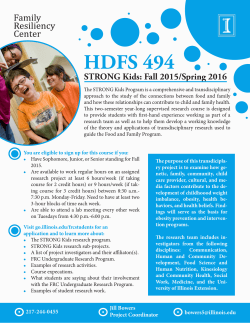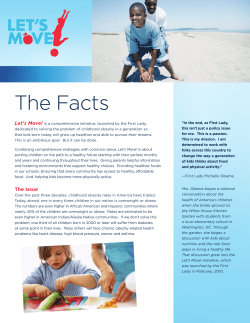
There’s a reason they call it the great outdoors.
There’s a reason they call it the great outdoors.® Remember playing outside until mom called you in for dinner? Today’s kids probably won’t. In the last two decades, childhood has moved indoors. The average American boy or girl spends just four to seven minutes in unstructured outdoor play each day, and more than seven hours each day in front of an electronic screen.1,2,3 This shift inside profoundly impacts the wellness of our nation’s kids. Childhood obesity rates have more than doubled the last 20 years; the United States has become the largest consumer of ADHD medications in the world; and pediatric prescriptions for antidepressants have risen precipitously.4,5,6 Our kids are out of shape, tuned out and stressed out, because they’re missing something essential to their health and development: connection to the natural world. “When I was young, we walked to school every day, rain or shine—in wind, sleet, hail and snow too. And we spent hours running around outside when school got out.” --First Lady Michelle Obama Body Outdoor play increases fitness levels and builds active, healthy bodies, an important strategy in helping the one in three American kids who are obese7 get fit. Spending time outside raises levels of Vitamin D, helping protect children from future bone problems, heart disease, diabetes and other health issues.8 Being out there improves distance vision and lowers the chance of nearsightedness.9 Mind Exposure to natural settings may be widely effective in reducing ADHD symptoms.10 Schools with environmental education programs score higher on standardized tests in math, reading, writing and listening. 11 Exposure to environment-based education significantly increases student performance on tests of their critical thinking skills. 12 Spirit Children’s stress levels fall within minutes of seeing green spaces.13 Play protects children’s emotional development whereas loss of free time and a hurried lifestyle can contribute to anxiety and depression.14 Nature makes you nicer, enhancing social interactions, value for community and close relationships.15 Getting kids back outside is an important societal issue that affects children of all races and socio-economic levels throughout America. National Wildlife Federation (NWF) encourages Americans to Be Out There™ for the health and wellbeing of our children. Be Out There (www.BeOutThere.org) galvanizes families and communities, corporations and partners, thought leaders and policy makers around solutions for addressing this indoor childhood epidemic. National Wildlife Federation® www.BeOutThere.org The American Academy of Pediatrics recommends 60 minutes daily of unstructured free play as an essential part of children’s physical and mental health and social development. Cal Tech’s Jet Propulsion Lab interviews all candidates about their play experiences as children, because they’ve found a direct correlation between hands-on play and superior problem solving skills. References 1 Hofferth, Sandra and John Sandberg (1999), “Changes in American Children’s Time, 1981-1997,” University of Michigan Institute for Social Research. 2 Juster, F. Thomas et al. (2004). “Changing Times of American Youth: 1981-2003,”Institute for Social Research, University of Michigan. http://www.umich.edu/news/Releases/2004/Nov04/ teen_time_report.pdf 3 Rideout, Victoria et al. (2010). “Generation M: Media in the Lives of 8-18 Year-Olds,” The Henry J. Kaiser Family Foundation. http://www.kff.org/entmedia/entmedia030905pkg.cfm 4 CDC's National Center for Chronic Disease Prevention and Health Promotion. Division of Adolescent and School Health. Childhood Obesity. 20 Oct. 2008. http://www.cdc.gov/HealthyYouth/obesity 5 Sax, Leonard, “Ritalin - Better Living Through Chemistry?” The World and I. Nov. 1, 2000. 6 Delate T, Gelenberg AJ, Simmons VA, Motheral BR. (2004) "Trends in the use of antidepressant medications in a nationwide sample of commercially insured pediatric patients, 1998-2002." Psychiatric Services. 55(4):387-391. 7 CDC's National Center for Chronic Disease Prevention and Health Promotion. Division of Adolescent and School Health. Childhood Obesity. 20 Oct. 2008. http://www.cdc.gov/HealthyYouth/obesity 8 American Academy of Pediatrics. “Many Children have suboptimal Vitamin D Levels,” Pediatrics. October 26, 2009. http://www.aap.org/advocacy/releases/oct2609studies.htm 9 What's Hot in Myopia Research-The 12th International Myopia Conference, Australia, July 2008. http://journals.lww.com/optvissci/Fulltext/2009/01000/ What_s_Hot_in_Myopia_Research_The_12th.2.aspx 10 Wells, N.M. (2000). At home with nature: Effects of “greenness” on children’s cognitive functioning. Environment and Behavior (32), 6, pp 775-795. http://eab.sagepub.com/cgi/content/abstract/32/6/775 11 Bartosh, Oksana. Environmental Education: Improving Student Achievement. Thesis. Evergreen State College, 2003. Web. http://www.seer.org/pages/research/Bartosh 2003.pdf. 12 Ernst, Julie (Athman) and Martha Monroe. “The effects of environment-based education on students’ critical thinking skills and disposition toward critical thinking.” 10.4 Environmental Education Research, Nov. 2004. 13 Kuo, PhD, Frances E., and Andrea Faber Taylor, PhD. "A Potential Natural Treatment for AttentionDeficit/Hyperactivity Disorder: Evidence From a National Study." American Journal of Public Health 94.9. Sept. 2004. http://www.pubmedcentral.nih.gov/articlerender.fcgi?artid=1448497 14 Ginsburg, MD MSEd, Kenneth R. Committee on Communications, and Committee on Psychosocial Aspects of Child and Family Health. “The Importance of Play in Promoting Healthy Child Development and Maintaining Strong Parent-Child Bonds.” 119.1 15 Weinstein, N., Przybylski, A. K., & Ryan, R. M. (2009). “Can nature make us more caring? Effects of immersion in nature on intrinsic aspirations and generosity.” Personality and Social Psychology Bulletin, 35, 1315-1329. National Wildlife Federation® www.BeOutThere.org
© Copyright 2025





















